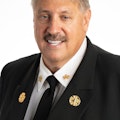My wife and I are talking about building our retirement home. It is interesting to look at all the architectural plans that are available on different websites. Just enter your parameters—how many bedrooms and baths, how wide and how deep, basement or no basement, attached or detached garage and how many cars in the garage, plus a lot of other features, such as vaulted ceilings in the great room—then hit the search button, and all the building plans come up with associated pictures and floor layouts.
I don’t know what we’ll eventually decide upon, but I do know I will not hire one person to carry the wood, one person to measure it, one person to saw it, and another person to nail it in place on the roof or the floor, or to create a wall separation. Instead, I will hire a carpenter. The carpenter can build my house, and I do not have to hire multiple people to do the job.
One person, multiple jobs
The beauty of the firefighter-paramedic and the fire-based EMS system is that you get the same results. You hire one person and they can fight fire, treat a cardiac arrest victim, mitigate a hazardous material spill, use extrication tools to cut someone out of a car, or crawl into a confined space to rescue someone. One firefighter can do multiple jobs.
When you have fire and EMS operating in the same organization, there are areas where they cross and can benefit each other. Other times, you train and practice one set of skills while doing another.
As an example, the next time you respond with your engine to a medical call, the engineer should practice parking the engine as if they were going on a fire call. If you’re going to a residence, either practicing parking the engine just past the house or just short of the house, as if you were leaving room for a ladder. If you’re the company officer, when arriving on the scene, practice (to yourself) giving a scene size-up. After the medical call is over, you can practice doing a 360 walk-around. Another thing an engine company crew can do after the medical call is complete is discuss the response effort if there had been a real fire in the same room where the medical patient was found: How many feet of hose would you need to make an attack? What would be the drop point? Where is the nearest hydrant to get a secondary water supply or would you have to wait on another engine? What obstacles would you face in getting a hoseline to the seat of the fire? There are many other great topics of discussion. All these actions, including where you park the engine and the other components needed to flow water onto the fire, are all excellent ways of creating muscle memory for when the real fire occurs.
If you’re a firefighter-paramedic assigned to an ambulance, you can also get out of your silo and get involved in fire operations. This is particularly true on the scene of a fire. I’ve seen many firefighter-paramedics just sit in the ambulance at the scene of a fire while engine and truck companies struggle to complete outside chores, including getting tools to the front of the building, getting ladders thrown to windows, cutting off utilities, helping other firefighters change out their air bottles or helping firefighters to rehab. In some fire departments, a firefighter-paramedic can be trained and serve as a safety officer on the scene of the fire. Of course, if a firefighter or a civilian is injured, they would need to transition back to their role of a medical care provider with an ambulance.
Another area of fire and EMS crossover involves firefighters switching apparatus so as to not fatigue or cause sleep deprivation for one firefighter. As a deputy fire chief in Memphis, TN, I implemented a system where the firefighter-paramedics would swap from the engine to ambulance and vice versa every 12 hours on a 24-hour shift. It was deeply appreciated by those who worked on busy ambulances and kept them from making poor decisions when exhausted.
See the value
There are many areas where EMS and fire cross and the true value of a fire-based EMS system is when they complement each other. When you behave as though there are two separate departments under the same administration, you lose that value.
About the Author
Gary Ludwig
GARY LUDWIG has served in three fire departments over his career: St. Louis, Memphis, and Champaign, IL. His fire, EMS and rescue career spanned a total of 46 years, and he has been a paramedic for over 44 years. Ludwig served as president of the International Association of Fire Chiefs in 2019-20. He has a Master’s degree in Business and Management, has written over 500 articles for professional fire and EMS publications and is the author of seven books.
Connect with Gary
Email: [email protected]
Facebook: Gary Ludwig
Twitter: @ChiefGaryLudwig
Website: garyludwig.com

